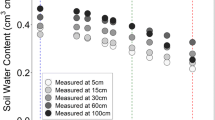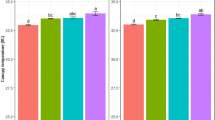Abstract
The present work deals with sweet sorghum canopy development in relation to the radiation capture and water demand. Two experimental sites and four cultivation periods with sweet sorghum (var. Keller and var. MN1500) were used in a plain of Central Greece. The water consumption by the crops, the aerial biomass production, the Leaf Area Index (LAI), as well as the radiation interception under various irrigation rates were monitored and analyzed. Key findings of the work include: (a) canopy penetration of Photosynthetic Active Radiation (PAR) is 10 times less than the global solar radiation, indicating that practically all PAR is intercepted by the leafage; (b) LAI values higher than 6.0 lead to no extra PAR capture and non-significantly higher biomass production; (c) rapid canopy development by rational use of water and fertilizer would attain capture and use of radiation at its maximum availability; (d) for the well watered plots, the Radiation Use Efficiency ranged from 2.8 to 3.63 g dry matter/MJ intercepted and the Water Use Efficiency (WUE) from 43 to 56.5 kg ha−1 mm−1, whereas the corresponding actual cumulative evapotranspiration ranged from 601 to 662 mm. In addition, the crop coefficient Kc values for the various cultivation stages of sorghum were evaluated.







Similar content being viewed by others
References
Albrizio R, Steduto P (2005) Resource use efficiency of field-grown sunflower, sorghum, wheat and chickpea I. Radiation use efficiency. Agric For Meteorol 130:254–268
Andrade FH, Uhart SA, Cirilo A (1993) Temperature affects radiation use efficiency in maize. Field Crop Res 32:17–25
Bell MJ, Wright GC, Hammer GL (1992) Night temperature affects radiation-use efficiency in peanut. Crop Sci 32:1329–1335
Biscoe PV, Gallagher JN (1977) Weather, dry matter production and yield. In: Landsberg JJ, Cutting CV (eds) Environmental Effects on Crop Physiology. Academic Press, London, pp 75–100
Ceotto E, Di Candilo M, Castelli F, Badeck FW, Rizza F, Soave C, Volta A, Villani G, Marletto V (2013) Comparing solar radiation interception and use efficiency for the energy crops giant reed (Arundo donax L.) and sweet sorghum (Sorghum bicolour L. Moench). Field Crop Res 149:159–166
Chapelle J, Meekers E, Scheuren C, Thirion M, Jacquemin JC (1996) Regional project: sorghum in Wallonia. In: Proceedings 1st European Seminar on Sorghum for Energy and Industry, Eur. Commission (DG XII) INRA, Ademe, Toulouse, France, 139–143
Charonnat C, Hevin C, Gosse G (1996) The French fibre sorghum network: first results. In: Chartier P, Ferrero GL, Henius UM, Hultberg S, Sachau J, Wiinblad M (eds) Proceedings 9th European Bioenergy Conference, Biomass for Energy and the Environment, Vol 1. Pergamon, Oxford, pp 603–607
Cosentino SL (1996) Crop physiology of sweet sorghum (Sorghum bicolour (L.) Moench) in relation to water and nitrogen stress. In: Proceedings 1st European Seminar on Sorghum for Energy and Industry, European Commission (DG XII) INRA, Ademe, Toulouse, France, pp 30–41
Cosentino SL, Riggi E, Mantineo M (1997) Sweet sorghum performance in relation to soil water deficit in south Italy. In: Li D (ed) Proceedings First International Sweet Sorghum Conference, Institute of Botany, Chinese Academy of Sciences, Beijing 100093, China, pp 430–443
Curt MD, Fernandez J, Martinez M (1995) Productivity and water use efficiency of sweet sorghum (Sorghum bicolor (L.) Moench) cv Keller in relation to water regime. Biomass Bioenergy 8(2):401–409
Curt MD, Fernandez J, Martinez M (1997) Productivity and radiation use efficiency of sweet sorghum (Sorghum bicolor (L.) Moench) cv Keller in central Spain. Biomass Bioenergy 14(2):169–178
Cowan IR (1982) Regulation of water use in relation to carbon gain in higher plants. In: Lange OL, Nobel PS, Osmond CB, Zigler H (eds) Physiological plant ecology II. Encyclopaedia of Plant Physiology, vol 12B. Springer-Verlag, Berlin, Heidelberg, pp 589–613
Dalianis C, Panoutsou C, Dercas N (1996a) Sweet and fiber sorghum, two promising biomass crops. In: Proceedings 1st European Seminar on Sorghum for Energy and Industry, European Commission (DG XII) INRA, Ademe, Toulouse, France, pp 173–176
Dalianis C, Alexopoulou E, Dercas N (1996b) Relationships of plant density with biomass and sugar content of sweet sorghum, In: Proceedings 1st European Seminar on Sorghum for Energy and Industry, European Commission (DG XII) INRA, Ademe, Toulouse, France, pp 213–217
Dercas N, Panoutsou C, Dalianis C (1996) Radiation use efficiency, water and nitrogen effects on sweet sorghum productivity. In: Proceedings 1st European Seminar on Sorghum for Energy and Industry, European Commission (DG XII) INRA, Ademe, Toulouse, France, pp 218–221
Dercas N, Liakatas A (1999) Sorghum water loss in relation to irrigation treatment. Water Resour Manag 13:39–57
Dercas N, Kavadakis G, Nikolaou A (2000) Evaluation of productivity, water and radiation use efficiency of two sweet sorghum varieties under Greek conditions. In: 1st World Conference on Biomass for Energy and Industry, Ed. James & James (Science Publishers) Ltd., Sevilla, pp. 1654–1657
Dercas N, Liakatas A (2007) Water and radiation effect on sweet sorghum productivity. Water Resour Manag 21:1585–1600
Doorenbos J, Kassam AH, Bentvelsen CLM, Branscheid V, Plusje JMGA, Smith M, Uittenbogaard GO, Van der Wal HK (1986) Yield response to water, FAO Irrigation and Drainage, Vol. 33, Rome, pp 193
Enciso J, Jifon J, Ribera L, Zapata SD, Ganjegunte GK (2015) Yield, water use efficiency and economic analysis of energy sorghum in South Texas. Biomass Bioenergy 81:339–344. https://doi.org/10.1016/j.biombioe.2015.07.021
Farré I, Faci JM (2006) Comparative response of maize (Zea mays L.) and sorghum (Sorghum bicolour L. Moench) to deficit irrigation in a Mediterranean environment. Agric Water Manag 83:135–143
Fletcher AL, Johnstone PR, Chakwizira E, Brown HE (2013) Radiation capture and radiation use efficiency in response to N supply for crop species with contrasting canopies. Field Crop Res 150:126–134
Garofalo P, Vonella AV, Ruggieri S, Rinaldi M (2011) Water and radiation use efficiencies of irrigated biomass sorghum in a Mediterranean environment. Ital J Agron 6(e21):133–139
Garofalo P, Rinaldi M (2013) Water-use efficiency of irrigated biomass sorghum in a Mediterranean environment. Span J Agric Res 11(4):1153–1169. https://doi.org/10.5424/sjar/2013114-4147
Goudriaan J, van Laar HH (1994) Modelling Potential Crop Growth Processes, Textbook with Exercises. Kluver Academic Publishers, Dordrecht
Hammer GL, van Oosterom E, McLean G, Chapman SC, Broad I, Harland P, Muchow RC (2010) Adapting APSIM to model the physiology and genetics of complex adaptive traits in field crops. J Exp Bot 61:2185–2202
Houx JH III, Fritschi FB (2015) Influence of late planting on light interception, radiation use efficiency and biomass production of four sweet sorghum cultivars. Ind Crop Prod 76:62–68. https://doi.org/10.1016/j.indcrop.2015.06.036
Hsiao TC, Bradford KJ (1983) Physiological consequences of cellular water deficits. In: Taylor HM, Jordan WR, Sinclair TR (Eds), Limitations to Efficient Water Use in Crop Production. American Society of Agronomy, Inc., Crop Society of America, Inc., Soil Science Society of America, Inc., Madison, Winsconsin, pp 227–265
Lemaire G, Chartier M (1996) Productivity models of sorghum crops In: Proceedings 1st European Seminar on Sorghum for Energy and Industry, European Commission (DG XII) INRA, Ademe, Toulouse, France, pp 42–50
Losavio N, Serio F, Scalcione E, Vonella A (1994) Sweet sorghum in the Mediterranean region: Productivity and water use efficiency, Proceedings 8th European Biomass Conference, Vienna, vol. 1, pp 640–645
Mastrorilli M, Katerji N, Rana G, Steduto P (1995) Sweet sorghum in Mediterranean climate: radiation use and biomass water use efficiencies. Ind Crop Prod 3:253–260
Mastrorilli M, Katerji N, Rana G (1999) Productivity and water use efficiency of sweet sorghum as affected by soil water deficit occurring at different vegetative growth stages. Eur J Agron 11:207–215
Monteith JL, Unsworth MH (1990) Principles of Environmental Physics, 2nd edn. Edward Arnold, London, p 291
Ottman MJ, Welch LF (1989) Planting patterns and radiation interception, plant nutrient concentration and yield in maize. Agron J 81:167–174
Rinaldi M, Garofalo P (2011) Radiation-use efficiency of irrigated biomass sorghum in a Mediterranean environment. Crop Pasture Sci 62:830–839. https://doi.org/10.1071/CP11091
Sakellariou-Makrantonaki M, Papalexis D, Nakos N, Kalavrouziotis IK (2007) Effect of modern irrigation methods on growth and energy production of sweet sorghum (var. Keller) on a dry year in Central Greece. Agric Water Manag 90:181–189
Sawargaonkar GL, Patil MD, Wani SP, Pavani E, Reddy BVSR, Marimuthu S (2013) Nitrogen response and water use efficiency of sweet sorghum cultivars. Field Crop Res 149:245–251. https://doi.org/10.1016/j.fcr.2013.05.009
Steduto P (2003) Biomass water-productivity. Comparing the growth-engines of crop models. In: FAO Expert Meeting on Crop Water Productivity Under Deficient Water Supply, Rome, pp 26–28
Tayot X, Chartier M, Varlet-Grancher C, Lemaire G (1994) Potential above-ground dry matter production of Miscanthus in north-central France compared to sweet sorghum. In: Chartier P, Beenackers AACM, Grassi G (eds) Proceedings 8th E.E. Conference, Biomass for Energy Environment, Agriculture and Industry, Vol 1. Pergamon, Oxford, pp 556–564
Tingting X, Peixi S, Lishan S (2010) Photosynthetic characteristics and water use efficiency of sweet sorghum under different watering regimes. Pak J Bot 42(6):3981–3994
Varlet-Grancher C, Chartier M, Lemaire G, Gosse G, Bonhomme R, Cruz P, Castal F, Lenoble S (1992) Productivity of sweet sorghum compared to sudan-grass and sorghum sudan-grass hybrids: Radiation interception and biomass accumulation under non limiting water and nitrogen conditions. In: Grassi G, Collina A, Zibetta H (eds) Proceedings 6th EC Conference. Biomass for Energy Industry and Environment, Elsevier Applied Science, Oxford, pp 265–267
Wang WF, Zong YZ, Zhang SQ (2014) Water- and nitrogen-use efficiencies of sweet sorghum seedlings are improved under water stress. Int J Agric Biol 16:285–292
Watiki JM, Fukai S, Banda JA, Keating BA (1993) Radiation interception and growth of maize/cowpea intercrop as affected by maize plant density and cowpea cultivar. Field Crop Res 35:123–133
Acknowledgments
Experiments were carried out by the authors in the context of AIR (CT92-0041. ‘Sweet sorghum’: A sustainable crop for energy production in Europe; Agriculture industrial improvement, optimization and implementation 1993-1995) and FAIR (CT96-1913 ‘Environmental studies on sweet and fibre sorghum, sustainable crops for biomass and energy’) programs, which were supported by the EU and the Greek Ministry of Industry, Energy and Technology, in the Centre of Renewable Energy Sources (CRES), Department of Biomass (Greece), Marathonos Ave. (19th km), 19009 Pikermi, Greece, Phone: +302106603300, www.cres.gr. The authors wish to express their acknowledgments to all the members of the Biomass Department for their contribution in carrying out the experiments. They are, also, thankful to John Tsiros, Professor at the AUA, for his constructive remarks on the manuscript of this paper.
Author information
Authors and Affiliations
Corresponding author
Rights and permissions
About this article
Cite this article
Dercas, N., Liakatas, A. Sweet Sorghum Canopy Development in Relation to Radiation and Water Use. Environ. Process. 5, 413–425 (2018). https://doi.org/10.1007/s40710-018-0300-0
Received:
Accepted:
Published:
Issue Date:
DOI: https://doi.org/10.1007/s40710-018-0300-0




